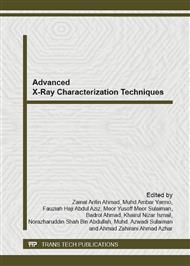p.309
p.314
p.320
p.325
p.330
p.335
p.340
p.345
p.350
X-Ray Spectrometry Study on Historical Decorative Glasses in Thailand: Lanna-Style Glass
Abstract:
t was known that historical objects were highly heterogeneous. Due to the complex nature of materials and objects, extremely sensitive, spatially resolved, multi-elemental and versatile analytical instruments were needed. The techniques employed should be as a noninvasive as possible and able to give complementary information from macroscopic to nanometer scales. In this work, X-ray based spectroscopy including energy dispersive X-ray fluorescence spectroscopy (EDS), Proton-induced X-ray emission spectroscopy (PIXE), and micro-beam X-ray fluorescence spectroscopy (µ-XRF) were used to analyze chemical composition of the Lanna-style glass. Microstructure was also studied. It can be concluded that these techniques in combination are powerful for the investigation of heterogeneous glassy materials.
Info:
Periodical:
Pages:
330-334
Citation:
Online since:
December 2012
Keywords:
Price:
Сopyright:
© 2013 Trans Tech Publications Ltd. All Rights Reserved
Share:
Citation:


